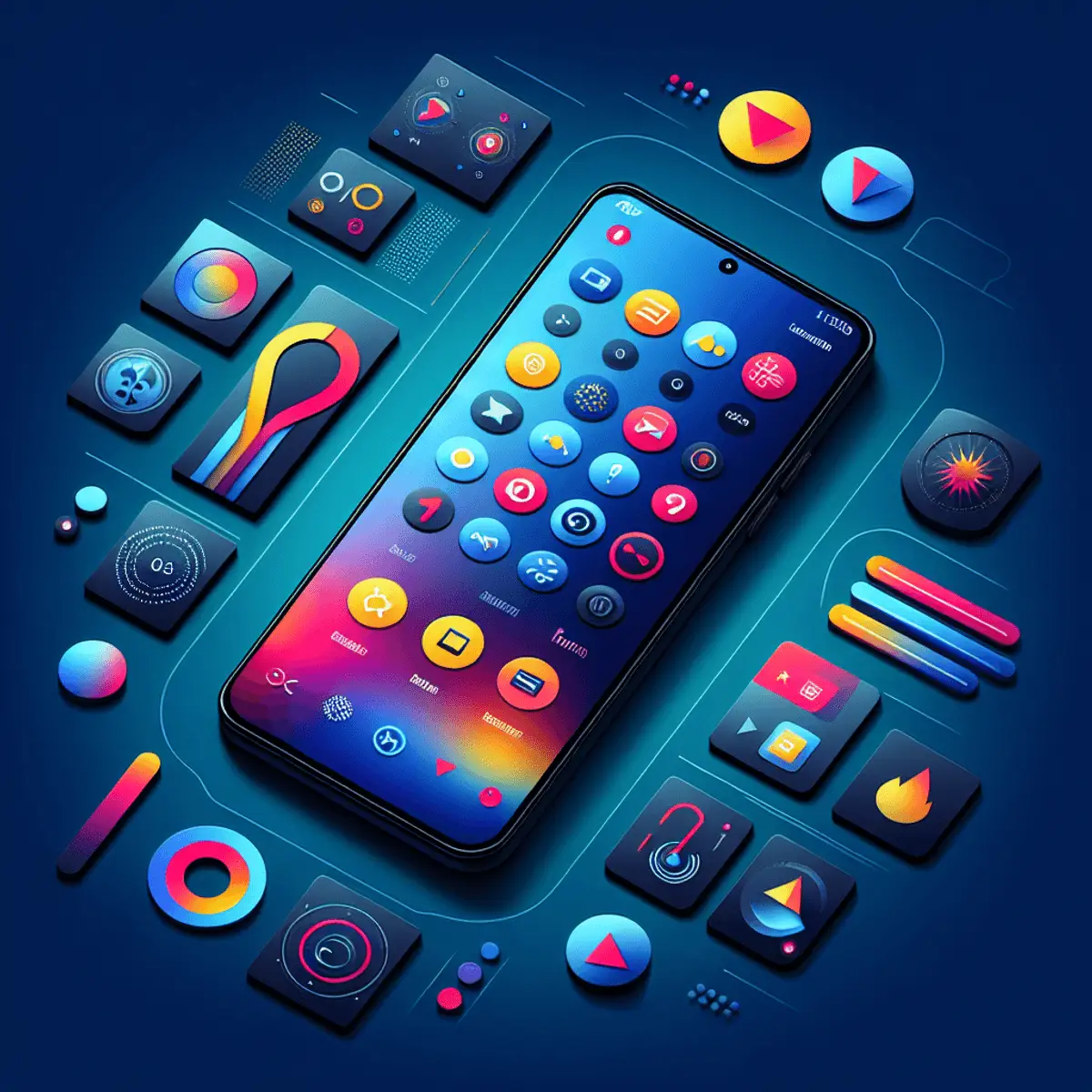
Top 2024 Mobile App Trends You Can’t Afford to Ignore
Welcome to the cutting edge of innovation where the digital landscape is constantly changing. As we move through 2024, it’s crucial for businesses and developers to stay updated with the mobile app development trends shaping the industry. These trends are not just passing fads; they are the key factors behind successful stories in our app-driven world.
This year, we’re witnessing a rise in technologies and strategies that are transforming how users engage with mobile applications. We have identified 15 top mobile app development trends that will have a significant impact on the market. From improving user engagement to leveraging the potential of artificial intelligence, these trends provide guidance for businesses looking to gain a competitive advantage.
Exploring these 2024 mobile app trends can provide companies with valuable insights and enable them to embrace innovative approaches to app design and features. In this article, we’ll uncover these crucial mobile app industry trends that have the potential to take your business to new levels of innovation and user satisfaction.
1. User Experience Trends
Understanding the importance of user experience in mobile apps is essential for businesses aiming for success in today’s digital world. A great user experience is a key factor in how your audience views your app and your brand as a whole. According to a report by PwC, 86% of buyers are willing to pay more for a great customer experience, highlighting the importance of focusing on user experience trends in mobile app development.
User Interface Design Trends
The world of UI design combines aesthetics with functionality. New trends such as metamorphism, which uses subtle shadows and light effects to mimic real-life objects, or 3D elements that add depth to flat designs, are changing the way mobile apps look.
Personalization and Customization in Mobile Apps
Personalization is now synonymous with a better user experience. By providing personalized content and allowing users to customize their settings based on their preferences and behavior, apps can create an experience that feels tailor-made for each individual, leading to higher engagement. Here are some ways to effectively incorporate personalization:
- Use machine learning algorithms to analyze how users behave within the app.
- Give users the option to set their preferences when they first start using the app.
- Customize push notifications based on users’ activity and interests.
By following these steps, you can increase user satisfaction just like Spotify did with its ‘Discover Weekly’ feature, which creates personalized playlists for listeners based on their music preferences.
Voice User Interface (VUI) Trends
As virtual assistants like Siri and Alexa become more popular, voice interactions are also becoming common in mobile apps. By including VUI elements in their apps, developers can make them easier to use and more accessible. Voice commands can be especially helpful for users who struggle with reading or typing. One example of a successful implementation of VUI is the Domino’s Pizza app, which lets users order pizza using voice commands through their virtual assistant, Dom.
The focus on user experience trends highlights the importance of making mobile apps more intuitive and personalized. By investing in these areas, businesses can meet the changing expectations of their users and stay competitive in the ever-evolving app market.
2. Artificial Intelligence and Machine Learning Trends
As we look into the future of mobile app development in 2024, it’s clear that Artificial Intelligence (AI) and Machine Learning (ML) will have a significant impact. These powerful tools are transforming the mobile app industry, driving creativity, and creating more opportunities for user involvement. Various sectors, including healthcare and online shopping, are utilizing these advancements to improve their mobile app offerings.
Predictive Analytics and Recommendation Engines in Mobile Apps
One prominent trend is the use of Predictive Analytics powered by AI. These complex algorithms examine user behavior data to provide personalized suggestions, enhancing user experience and interaction.
For example, popular streaming platforms like Netflix or Spotify employ predictive analytics to curate content based on individual preferences. Similarly, e-commerce websites like Amazon recommend products based on browsing history and purchase habits. By incorporating such AI-generated recommendations, businesses can significantly increase user retention rates and app revenue.
Natural Language Processing (NLP) and Chatbot Trends
Another significant AI trend in mobile apps is the integration of Natural Language Processing (NLP) and chatbots. NLP technology has made great strides, enabling chatbots to better understand human language in its proper context.
Chatbots are no longer restricted to customer support functions. They have evolved into ‘virtual companions,’ offering personalized help, entertainment, or even mental health assistance within various apps. For instance, Woebot, a mental health app, employs an NLP-driven chatbot to teach users coping techniques for stress or depression.
By incorporating conversational chatbots into mobile apps, businesses can greatly improve user interactions, making them feel valued and heard.
In summary, as we explore the top trends in mobile app development for 2024, it’s clear that AI and ML will play a crucial role in creating innovative app experiences. The potential uses for these technologies are vast, with predictive analytics, recommendation engines, NLP, and chatbots leading the way.
3. Augmented Reality (AR) and Virtual Reality (VR) Trends
Augmented Reality (AR) and Virtual Reality (VR) have become extremely popular, changing the way we experience mobile apps with their ability to completely transform our surroundings. These technologies are not limited to just improving gaming and entertainment; they are also redefining how stories are told and how people interact with digital content. The combination of digital elements and the real world in AR, along with the fully immersive environments created by VR, are continuously pushing the limits of innovation.
AR-based Marketing and Advertising Trends
- Interactive Campaigns: Brands are using AR to create marketing campaigns that provide an interactive element to the shopping process. For example, cosmetic companies have developed virtual try-on apps using AR, allowing customers to see how makeup products look on their faces before buying them.
- Virtual Try-On: Fashion retailers have introduced virtual fitting rooms through AR technology, enabling customers to visualize clothes and accessories on themselves without having to visit a physical store.
- Engaging Experiences: IKEA Place is a great example of an AR app that allows users to see how furniture would look and fit in their homes, making decision-making easier and improving customer satisfaction.
VR Gaming and Entertainment Trends
- Multiplayer Experiences: Mobile VR gaming has evolved from being a solo activity. New platforms now support multiplayer modes where users can interact with others in a virtual space, creating social communities within the gaming world.
- Cinematic Storytelling: VR is giving creators the ability to tell stories in an immersive way. Apps like “Within” offer a wide range of VR films and experiences that transport viewers directly into the story.
- Realism and Immersion: Popular VR games like “Beat Saber” combine music rhythm with lightsaber-wielding action, demonstrating how VR can create lifelike and highly immersive environments that grab users’ attention.
The use of AR in marketing and advertising shows how effective it can be in engaging consumers, while the impact of VR in gaming highlights its ability to provide captivating entertainment. These trends indicate that mobile apps utilizing AR and VR technologies are opening up new avenues for users to explore digital content—blurring the boundaries between the real world and the virtual realm.
4. Internet of Things (IoT) Trends
The combination of mobile apps and Internet of Things (IoT) technology is not just a passing trend; it’s a significant change that is reshaping how we use everyday objects, from kitchen appliances to fitness trackers. This shift towards a more connected and automated world is happening right now.
Smart Home Technology Trends
IoT in smart homes, home automation
Voice-Controlled Assistants
The popularity of voice-controlled assistants in smart homes has been incredible. Thanks to IoT devices and mobile apps, users can now easily control their home environment using voice commands. For example, apps that work with Amazon Echo or Google Home allow users to effortlessly manage their lighting, thermostats, and even security systems.
Energy Management Systems
IoT technology is also making great progress in energy efficiency through smart thermostats and lighting systems that adapt to user behavior. Mobile apps like Nest or Philips Hue give users the ability to optimize their home’s energy usage, leading to cost savings and environmental benefits.
Interconnected Appliances
Manufacturers are now adding IoT capabilities to household appliances, enabling them to communicate with mobile apps. This feature allows users to monitor and control their appliances remotely, bringing convenience and peace of mind.
Challenges and Opportunities
Developers who want to create impactful smart home applications need to navigate the complexities of device compatibility, security issues, and user privacy. The key opportunity lies in developing strong apps that can securely manage multiple IoT devices while providing a seamless user experience.
Wearable Devices and Connected Health Applications
IoT wearables, fitness tracking apps
Healthcare Integration
Wearables have expanded beyond fitness tracking into the healthcare industry. Devices like the Apple Watch can now send important health data directly to mobile apps, which can then monitor things like heart rate variability, and blood oxygen levels, and even detect falls.
Fitness Tracking Proliferation
Fitness enthusiasts are increasingly using wearables connected to mobile apps for detailed information about their workouts. Apps that sync with devices like Fitbit or Garmin can track steps taken, calories burned, and sleep patterns, and even provide personalized coaching.
Design Considerations for Wearables
When designing apps for wearables, developers must take into account factors such as limited screen space and battery life. The focus should be on delivering concise information and ensuring that interactions are easy to understand, leading to a better user experience.
By adopting IoT trends in mobile app development, businesses can discover new opportunities in automation and connectivity. These trends are paving the way for innovative solutions that improve everyday life through efficiency and personalized experiences. With careful planning and execution, developers have the power to redefine how humans interact with technology in various areas.
5. Security and Privacy Trends
In today’s world, where cyber threats are increasing and personal information is highly valuable, security and privacy have become extremely important in mobile app development. Both developers and businesses must prioritize these aspects to protect their users, earn their trust, and comply with strict regulations.
Biometric Authentication Trends
As people look for stronger ways to prevent identity theft and fraud, biometric authentication has become a crucial feature in mobile app security. Here’s how this technology is changing user verification:
- Facial Recognition: Once seen only in movies, facial recognition is now available on everyday mobile devices. It uses specific characteristics of a person’s face to grant access, providing high-level security due to the complexity of facial features.
- Fingerprint Scanning: One of the first biometric authentication methods for mobile apps, fingerprint scanning uses the unique patterns on a person’s fingerprint to create a special identifier, making it extremely difficult for unauthorized individuals to gain entry.
Implementation Tips:
- Make sure that biometric data is stored securely on the device and never sent over the internet.
- Offer alternative authentication options for situations where biometrics may not work (such as finger injuries affecting fingerprint recognition).
- Regularly update algorithms to stay ahead of new methods used by hackers.
Biometric authentication not only aims to shield users from external dangers but also simplifies the login process by providing quick yet secure access without requiring passwords or PIN codes.
Security and privacy will keep evolving as new threats come up and technologies advance. By incorporating these state-of-the-art solutions into mobile app development, businesses can give their users peace of mind while establishing higher standards in data protection.
Conclusion
Harnessing the power of the 2024 mobile app development trends offers a pathway to innovation and differentiation in a crowded marketplace. As you steer your mobile app projects forward, remember that while it’s essential to stay abreast of technological advancements, the true compass for success lies in aligning these trends with the unique needs and preferences of your target audience.
Here are three key takeaways to guide you:
- Embrace Personalization: Utilize AI, AR/VR, and IoT to create bespoke experiences.
- Prioritize User Experience: Design interfaces that are intuitive and engaging, incorporating VUI for added convenience.
- Innovate Responsibly: Balance cutting-edge features with robust security practices.
Encourage your development team to think outside the traditional app framework. By doing so, you position your app not just as a tool but as an experience that resonates with users on a personal level.
The trends discussed are not just fleeting fads; they are the building blocks for the next generation of mobile applications that will captivate and delight users.
In the dynamic realm of mobile apps, those who harness these trends effectively while remaining true to their core vision will be the ones to shape the future. Let 2024 be a year marked by bold steps toward innovation, thoughtful integration of technology, and an unwavering commitment to delivering value to users.





